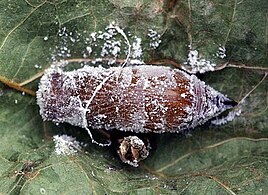Long-tailed skipper
| Long-tailed skipper | |
|---|---|

| |
| Scientific classification | |
| Kingdom: | |
| Phylum: | |
| Class: | |
| Order: | |
| Family: | |
| Genus: | |
| Species: | U. proteus
|
| Binomial name | |
| Urbanus proteus | |
The long-tailed skipper (Urbanus proteus) is a spread-winged skipper butterfly found throughout tropical and subtropical South America, south to Argentina and north into the southern part of the United States of America. It cannot live in areas with prolonged frost. It is a showy butterfly, with wings of light brown tinted with iridescent blue, and two long tails extending from the hindwings. The robust body is light blue dorsally. It has a large head, prominent eyes, and a wingspan between 4.5 and 6 centimeters.
Life cycle
It lays white or yellow eggs, singly or in small clusters, which hatch into a caterpillar with a yellowish body and large, dark head. After two to three weeks, the caterpillar forms a pupa. Its pupa is contained in a rolled leaf and covered in fine bluish hairs. The pupa stage may last from one to three weeks, after which the adult emerges.[1]
The caterpillar of this skipper is a common pest of crops, especially beans, in the southern United States. For this reason, it is sometimes called the bean leafroller in that area. The caterpillars are also known to attack ornamental plants in the legume family such as wisteria and butterfly peas. The caterpillars feed on leaves and then roll the leaves around themselves, lining the cavity with silk, to pupate. The adults feed on nectar from flowers. Natural enemies of this species include wasp and fly parasitoids, and the Florida predatory stink bug, (Euthyrhynchus floridanus). In the fall, a nuclear polyhedrosis virus killed up to 50% of the larvae.[1]
Sub-species
U. p. domingo flies in the Bahamas and throughout the West Indies, but it is only weakly differentiated from the nominate form, chiefly by its reduced white markings.[2]
-
Pupa
-
Caterpillar
-
U. p. domingo, Jamaica
-
U. p. domingo, Grand Cayman
References
- ^ a b Capinera, John L. (2001). Handbook of Vegetable Pests. Gulf Professional Publishing. pp. 364–365. ISBN 978-0-12-158861-8.
- ^ R. R. Askew and P. A. van B. Stafford, Butterflies of the Cayman Islands (Apollo Books, Stenstrup 2008) ISBN 978-87-88757-85-9, pp. 117-119
- Butterflies and Moths of North America Fact Page
- U. proteus on the UF/IFAS Featured Creatures Web site
- Butterflies of Houston and Southeast Texas, by John & Gloria Tveten
- Hesperiidae
- Butterflies of Central America
- Butterflies of the Caribbean
- Butterflies of North America
- Hesperiidae of South America
- Butterflies of Mexico
- Butterflies of the United States
- Lepidoptera of Brazil
- Lepidoptera of Colombia
- Lepidoptera of Costa Rica
- Lepidoptera of Ecuador
- Lepidoptera of Panama
- Lepidoptera of Venezuela
- Fauna of the Amazon
- Insects described in 1758
- Taxa named by Carl Linnaeus
- Agricultural pest insects





